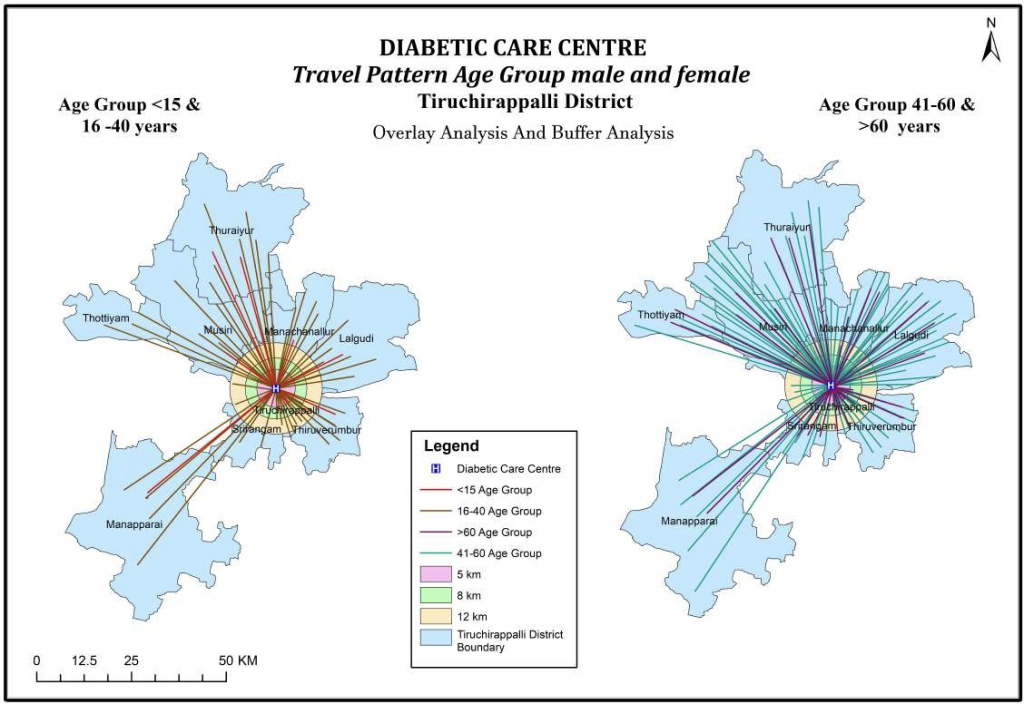
Author: Harnishya Palanichamy
Mentor: Dr. Balaji
The International School Bangalore
Abstract
Diabetes is a disease characterized by increased insulin resistance and decreased insulin secretion in response to glucose stimulants. It is an epidemic rising in prevalence worldwide, with many contributing factors, including Body Mass Index, lifestyle, family history, ethnicity, etc. Diabetes must be constantly monitored and effectively subdued with proper medication and by adapting to a healthy lifestyle. And this becomes possible through the comfortable, convenient, and serene access to a health care centre. The main aim of this study is to examine sex-wise and age-wise travel patterns of the patient’s access, from nine taluks to a private Diabetic Centre, located in Tiruchirappalli city, Tamil Nadu, India. The data are collected using a Multivariate Random sampling method, from 225 patients, during 2019, 2020, and 2021, for nine taluks in Tiruchirappalli district. The Statistical techniques used in the present study is the Proximity Analysis using Multiple ring buffer method. The Overlay analysis is done using Arc GIS. The study describes patients’ travel patterns with respect to their age and sex, in accessing a Diabetic Centre located in Tiruchirappalli City.
I. Introduction
Diabetes is one of the public health priorities in the world due to its chronicity and premature mortality associated with the disease [1]. Globally, 463 million people in the age group of 20–79 and one in five older adults (>65 years) has diabetes [2]. Diabetes is a disease that must be constantly monitored and effectively subdued with proper medication and healthy lifestyle and this becomes possible through the comfortable, convenient, and serene access to a health care centre. Easy access to a health care facility is essential in diabetes it requires the management process to be life-long and the patient’s continuous engagement with the health system [3]. One of the unexplored aspects of diabetes in India is the health care accessibility or distance travelled by the patients to seek their care [4]. There are evidences that distance is a barrier to health care utilization and frequency of visits [5] [6]. The main aim of this study is to examine sex-wise and age-wise travel patterns of the diabetic patients, from nine taluks accessing a private Diabetic Centre, located in Tiruchirappalli city, Tamil Nadu, India.
II. Objectives, Data, Methodology
The objective of the study is to analyse the travel pattern of patients from their residence to a Diabetic Centre located in the study area, with respect to patterns like age and sex. The data are collected using a Multivariate Random sampling method, from 225 patients, during 2019, 2020, and 2021, for nine taluks in Tiruchirappalli district. The Statistical techniques used in the present study is Proximity Analysis using Multiple ring buffer method. The Overlay analysis is done using Arc GIS.
III. Study Area
Tiruchirappalli district is situated in Tamil Nadu on coordinates of 10°100’N to 11° 300’N latitude and 78°00’E to 79°00’E longitude, covering an area of 4,404 sqkm, with a population of 1,182,000, as per 2011 census. It has nine taluks, 14 blocks and 404 village panchayats [Fig 1]. The study site is Diabetic Centre (H), located in Thillai Nagar, Tiruchirappalli city. Thillai Nagar is the poshest commercial and elite residential locality with a daily floating population of 5 lakhs. It is the hub for hospitals, clinics and nursing homes that are better equipped to offer personalized care with an excellent doctor-to-patient ratio.

IV. Result and Discussion
1. Sex Wise Travel Pattern: Using Buffer and Overlay Analysis
The data for the sex wise travel pattern of the patients, for male and female, accessing a Diabetic Centre is collected, calculated and is shown in Table 1. It represents the data collected from total number of Male (X), Female (X) patients and the calculation of mean (x̅). The Figures 2 and 3 shows the Buffer analysis of Sex wise travel pattern of Male & Female respectively. Three buffer zones (5km,8km,12km) are created to represents the sex wise travel pattern to the diabetic centre in the study area. Each lines denotes 5 persons from a particular taluk. The average number of male patients is 15.55 and the female patients is 9.44. In Tiruchirappalli, Musiri, Lalgudi, and Manachanallur, the male and female travel pattern is noticed to be higher than other taluks. The results show that the male patients travel longer distance than the female patients. The Figure 4 shows the Buffer and Overlay analysis of Sex wise travel pattern of Male & Female. From the figure, it could be observed that the patients access the Diabetic centre almost from all cardinal directions. The travel pattern of female patients is minimal, when compared with male patients. Beyond 12km buffer line, the travel pattern of male and female are noticed to be less.




Fig 3: Sex wise Travel pattern- Buffer Analysis- Female

Fig 4: Sex wise Travel pattern- Buffer and Overlay Analysis-Male and Female
2. Age Wise Travel Pattern: Using Buffer and Overlay Analysis
Age structure is one of the prominent factors in health care and health analysis. The data for the age wise travel pattern of the patients, male and female, accessing a Diabetic Centre is collected, calculated and is shown in Table 2. It represents the data collected from total number of the patients, male and female (X) and the calculation of mean (x̅), for age groups- <15, 16-40, 41-60 and >60. Among the total respondents, the age groups belonging to 41-60 constitute the highest number of the patients, followed by the age groups >60 (62 patients), 16-40 (55 patients). The age group <15 has the lowest number of patients (9 in number).
The Figure 5 shows the Buffer and Overlay analysis of Sex wise travel pattern of Male & Female patients. Three buffer zones, for 5km, 8km and 12 km are drawn to assess the age wise travel pattern of the patients. The results prove that the age group (41-60) travel a longer distance compared with other age groups.


IV. Conclusion
The travel pattern of the diabetes patients to access a Diabetic Centre in Tiruchirappalli city is analysed in the present study. The sex wise and age wise travel pattern is calculated and mapped, using buffer and overlay analysis. The analysis of the sex wise travel pattern of the patients proves that the female patients prefer a shorter travel distance than men patients. The age wise travel pattern proves that the patients in the age group of 41-60 travel longer distance than other age groups. The results of the present study reveal that distance play a vital role for the patients to access the health services.
V. Acknowledgment
The authors of this paper would like to acknowledge the Dr. Balaji, for his support in data analysis and mapping.
VI. References
[1] World Health Organization, n d. Diabetes [WWW Document]. World Heal. Organ. URL https://www.who. int/news-room/fact-sheets/detail/diabetes (accessed 28 .10. 20).
[2] The International Diabetes Federation, n d. International Diabetes Federation – Diabetes in SEA [WWW Document]. URL https://idf.org/our-network/regionsmembers/south-east-asia/diabetes-in-sea.html (accessed 28. 10. 20).
[3] Olickal, J., Devasia, J. T., Thekkur, P., Chinnakali, P., Suryanarayana, B. S., Kumar Saya, G., … & Subrahmanyam, D. K. S. (2021). How far persons with diabetes travel for care? Spatial analysis from a tertiary care facility in Southern India. Annals of GIS, 27(4), 341-349.
[4] Rekha, R. S., S. Wajid, N. Radhakrishnan, and S. Mathew. 2017. “Accessibility Analysis of Health Care Facility Using Geospatial Techniques.” Transp. Res. Procedia 27: 1163–1170. doi:10.1016/j.trpro.2017.12.078
[5] Bronstein, J. M., and M. A. Morrisey. 1990. “Determinants of Rural Travel Distance for Obstetrics Care.” Med. Care 28 (9): 853–865. doi:10.1097/00005650-199009000-00013
[6] Nemet, G. F., and A. J. Bailey. 2000. “Distance and Health Care Utilization among the Rural Elderly.” Soc. Sci. Med 50 (9): 1197–1208. doi:10.1016/S0277-9536(99)00365-2
About the author

Harnishya Palanichamy
Harnishya is currently in Grade 11 and is passionate about computer science and Artificial Intelligence. Playing football, piano, debate, hiking, reading and 3D printing are some of her pastimes.
